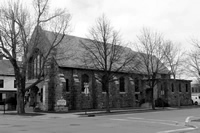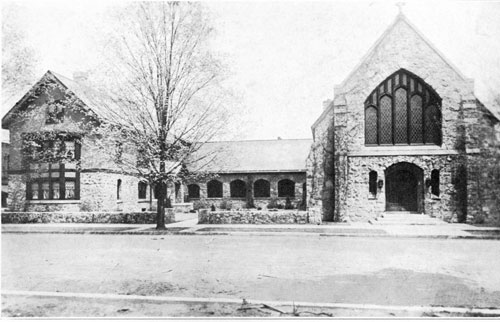The Ecumenical Tour Series will take you on a Walking/Driving Tour that highlights the varied and beautiful historic churches in downtown Wausau. Go for a nice walk, or sit back and take a pleasant ride. Either way, we hope you enjoy your discovery of the history and inspired architecture of these magnificent churches.

You are visiting St. John the Baptist Episcopal Church, where you can enjoy a lovely courtyard that is open to the public. Have a seat in one of the patio chairs, that have been provided for your comfort. Enjoy the quality of craftsmanship and the warm, welcoming comfort of the architectural design of this truly historic church.
st. john's episcopal church
Source: Marathon County Historical Society, "Historic Buildings of Downtown Wausau"

In 1858, Walter McIndoe deeded land to the Episcopal Church of Saint John in the Wilderness, led by Rev. Thomas Greene. Construction began that year, but went unfinished, and a windstorm in 1863 destroyed what had been completed. After serving in the civil war, Rev. Greene resumed construction of the wood framed church which was completed in 1867. By 1914 the church was replaced with a new Tudor Revival structure built of Hatley field stone and designed by the Wausau firm Speer and Swarthout. The name was also updated to Saint John the Baptist, reflecting that Wausau at this time was no longer a wilderness. A stone stucco parish house, designed by Oppenhamer and Obel of Wausau and Green Bay, was added on the west side of the property in 1922. The guild hall, connecting the church and the parish house, sheathed in stone, is the original 1867 building.
Source: History of the Diocese of Fond du Lac and Its Several Congregations
By A. Parker Curtiss, Fond du Lac: P.B. Haber Printing Co., 1925.
WAUSAU
ST. JOHN'S CHURCH
The Church came to Wausau with the early settlers. There were a few scattered families, a few stores and several saw mills. The first services were held at Forest House, an inn owned by Mr. Charles Single, father of Mrs. C. F. Dunbar who is still an active communicant of the parish. The Rev. Thomas Green, living at Stevens Point, officiated, driving through winter storms and summer heat over roads decidedly different from our paved roads of today.
St. John's Church was organized as a parish on September 22nd, 1858, by the Rev. Thomas Green, Rector, Thomas Youles and Charles Single, wardens, John C. Clark, Benjamin Single, Burton Millard, Fredrich W. Tyler, Thomas Single, J. A. Farn-ham, Charles Shuter, and William C. Clemson, vestrymen.
The articles of incorporation were filed in the office of the clerk of the circuit court of Marathon County, Wis., on November 1st, 1858. In the same year the frame of a church was erected on the site of the present church, which had been deeded to Bishop Kemper of the Diocese of Wisconsin in 1857 by the Hon. W. D. Mclndoe of Wausau.
The civil war came on, hard times prevailed. Father Green enlisted in the army, the little wooden church was never completed, and the frame was blown down. Father Green returned to Wausau in 1867 and was elected Rector. In the same year a church was built on the foundation of the old frame. This church was consecrated by Bishop Armitage in 1873.
Father Green resigned October 1st, 1873 and was succeeded by the Rev. Philip McKim in 1874 who resigned in 1876, and was followed by the Rev. J. A. Davenport who remained only one year. From September 30th, 1877 to September 18th, 1881, the Rev. Thomas Green was again rector of the parish, resigning on the latter date and being elected as Rector-emeritus.
The Rev. William Wright became rector on October 1st, 1881. In the following year the rectory was built and an indebtedness of about $1800.00 incurred for the purpose. In 1886 the church building was repaired and improved at considerable expense. Father Wright resigned in February, 1891, and in July of the same year was succeeded by the Rev. A. G. E. Jenner who was rector until December, 1893.
The Rev. John A. Carr became rector on January 7th, 1894. In 1895, the building indebtedness was paid by individual subscriptions, largely through the efforts of the senior warden, Mr. M. B. Atwater. Father Carr resigned on January 31st, 1898, and was succeeded by the Rev. W. J. Cordick who was rector until May 1st, 1903.
The Rev. George Hirst was rector from October 24th, 1903 until March 24th. 1904, and he was succeeded by the Rev. E. M. Thompson on May 15th, 1904. During Father Thompson's incumbency the floating debt was fully paid. He resigned in 1908 and was followed by the Rev. Wm. E. Johnson in October of the same year. In 1909 through the efforts of Father Johnson, St. John's Hospital Association was organized and out of it grew the present Children's Infirmary of Wausau.
During the last year of his rectorship Father Johnson devoted a portion of his time to general missionary work, and the Rev. L. M. Grant who was then in deacon Orders, was chosen his assistant. Upon the resignation of Father Johnson in February, 1912, Mr. Grant took charge of the services until his ordination to the priesthood in September, 1912, when he became Rector of the parish. During this time through the efforts of St. Martha's Guild, a pipe organ costing about $1,800.00 was installed in the church. Father Grant resigned June 1st, 1913, and on September 1st of the same year the Rev. John Lloyd became the Rector of the parish.

In the following spring, the parish decided to build a new church of stone, move the old church to the north side of the lot, connect it with the new church and convert it into a parish house. A building committee of five, composed of D. C. Everest, John Lull, P. O. Means, L. A. Pradt and M. B. Rosenberry, was appointed to carry out that purpose. The canvass for the necessary subscriptions was made during the summer of 1914, and pledges amounting to about $25,000.00 were made.
Messrs. Chromaster, Speer and Harvey Swarthout of Wausau, were selected as the architects for the building and on September 11th, 1914, the contract for the construction work was made with the Herman Construction Co., of Antigo, Wis. The corner stone of the new church was laid by the Ven. E. Croft Gear, Archdeacon of Stevens Point, acting for Bishop Weller, in October 19th, 1914.
The first services were held in the new church in March, 1915, and on Wednesday, May 12th, 1915, the church was consecrated by Bishop Weller. The Rev. John Lloyd resigned October 31st, 1917. The Rev. Cuthbert F. Hinton became rector of the parish on November 1st, 1917, and under his guidance the parish continued to grow and prosper. Father Hinton resigned on October 31st, 1920.
On April 1st, 1921, the Rev. William C. Way became rector and occupies that position at the present time. At the annual parish meeting in January, 1922, it was decided to build a new rectory of stone to the height of the second floor, and from there up to use hollow tiles covered with cement. The guild hall was also to be enlarged by an addition to the west end of 12.4 by 39 feet. A building committee composed of D. C. Everest, L. A. Pradt and Dr. Joseph F. Smith was appointed. Messrs. Oppenhamer and Obel of Wausau were chosen as the architects, and the Otrich and Shropshire Co. of Stevens Point were given the contract for construction. The cost of the rectory and the addition to the guild hall was about $27,000.00. Pledges amounting to $16,000.00 were made by members of the parish, and $3,000.00 by the faithful members of St. Martha's Guild.
The rector and his family moved into the new rectory in November, 1922. In March, 1923, the church was enriched and beautified by the installation of four memorial windows, given in memory of Charles and Elizabeth Single, Robert Parcher, Mrs. Mary Parcher, and Mrs. Josephine Single Baldwin. These windows were made by the Ford, McNutt Co., of Minneapolis. The designs are in accordance with a complete plan for windows for the whole church, by which will be shown events in the life of St. John the Baptist.
On Whitsunday, May 20th, 1923, the windows were dedicated by Bishop Weller, and the next afternoon was the benediction of the new rectory by the Bishop.
At the time of this publication (1925), St. John's parish had a property valued at $105,000, and was considered as one of the most beautiful Church properties in the State. The 1925 members of the vestry were: Senior Warden, Hon. L. A. Pradt; Junior Warden, Dr. Joseph F. Smith; Vestrymen: Dr. G. G. Anderson, D. C. Everest, George Giffin, John B. Hall, R. E. Puchner, T. H. Ryan, Jas. Silverthorn.



.